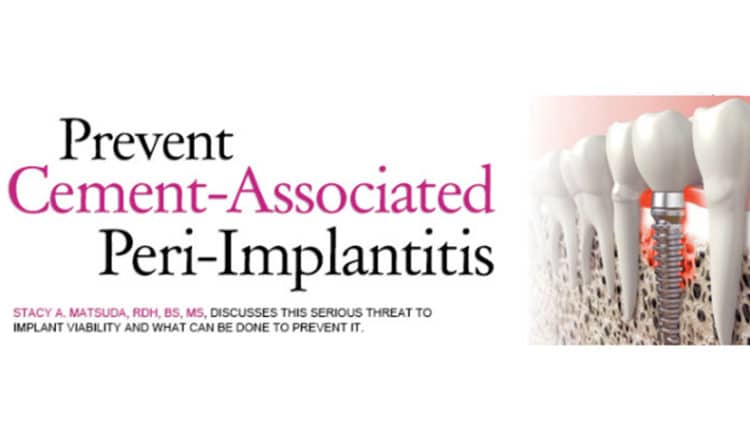
Prevent Cement-Associated Peri-Implantitis – Bonus Content
Stacy A. Matsuda, RDH, BS, MS, discusses this serious threat to implant viability and what can be done to prevent it.
Dental implants are increasingly the most desired treatment option for tooth replacement. While preferred for the long-term integrity of a functional dentition, implants are more vulnerable to the destructive effects of microbial incursion vs natural teeth,1 and, once initiated, destruction can occur rapidly and without warning.2 This brings a heightened responsibility for diligence and skill in the monitoring and maintenance of peri-implant health—a role primarily assumed by the dental hygienist.
What should dental hygienists know concerning missing teeth when conversing with their patients?
Regeneration is a game changer in oral implantology. With the many advances in regenerative therapies, the oral cavity can now be bioengineered back to a state of masticatory function. Previously atrophied bone in edentulous areas can be rebuilt to become recipient sites for implants. Patients generally are not aware of these options and may not know the appropriate questions to ask.
Given the cumulative detrimental effects of edentulism on nutritional, social, and psychological health and well-being, dental hygienists play a pivotal role in educating patients on the various sequellae associated with tooth loss. More importantly, patients need to be informed of the various treatment options aimed at oral rehabilitation, including ridge augmentation and regenerative procedures.
Dental technology continues to evolve. What do you see as having made a substantial impact on the success of implant therapy?
Implant treatment planning is designed to ensure successful implant outcomes. Traditional two-dimensional radiography can severely limit the ability to estimate bone volume and pinpoint vulnerable anatomic structures, such as the sinus floor and alveolar nerve. The advent of three-dimensional imaging has found a solution to these limitations.
Cone-beam computed tomography (CBCT) is an indispensable tool for spatial consideration in implantology, allowing precision and accuracy for planning site preparation and positioning, while averting drastic surgical placement errors such as nerve impingement. (FIGURE) Advanced diagnostic imaging can facilitate anticipated treatment outcomes for patients.
What spurred your interest in dental implants?
I have been fortunate to attend American Academy of Periodontology annual sessions, Academy of Osseointegration meetings, and select scientific conferences and clinical symposia over the years, where I was fortunate enough to listen to the lectures of the esteemed thought leaders and researchers who pioneered contemporary periodontal therapy. My husband, Mel Matusda, DDS, PC, received training in oral implantology from Per-Ingvar Brånemark, MD, PhD, in the early 1980s, and he has since placed thousands of dental implants in our periodontal practice. He has been committed to staying on the cutting edge of evidence-based care since beginning his practice in 1978, and we feel a sense of duty and pride in being able to offer the most advanced, proven therapies to our patients.
I took my first implant certification course soon afterward and achieved Fellowship status in the Association for Dental Implant Auxiliaries—the component arm of the International Congress of Oral Implantology. Because we have been placing and maintaining dental implants in our patients for 30 years, we have seen firsthand what works.
Our enthusiasm for periodontics and implants rubbed off on our son Michael Matsuda, DDS, a board-certified periodontist who is a partner in practice with his dad. Together, we continue to practice and also teach at Oregon Health & Science University School of Dentistry, Portland, part time. I am most fortunate to share this unique bond with my family.
REFERENCES
- Lee A, Wang HL. Biofilm related to dental implants. Implant Dent. 2010;19:387–393.
- Belibasakis GN. Microbiological and immuno-pathological aspects of peri-implant diseases. Arch Oral Biol. 2014;59:66–72.
From Dimensions of Dental Hygiene. November 2014;12(11):34,36–37.

